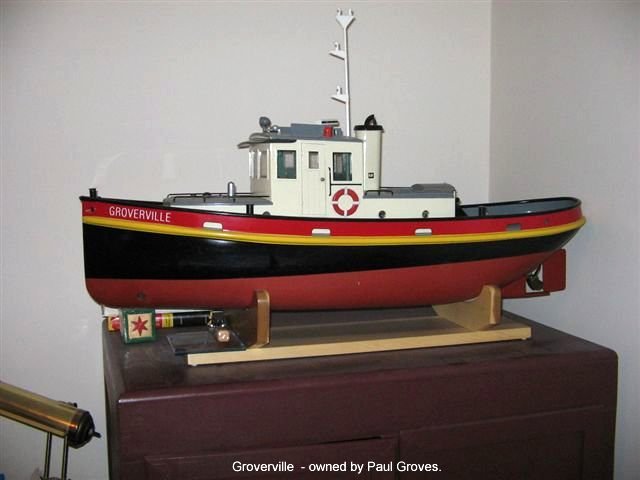|
Joe Fossey and Roger Hauka produced several Ville class models, 40" in length.
R/C Ville Class Models
Joe Fossey notes: This model (Chanceville) was built for Barrie Model Yacht Club member Tim Chance by fellow B.M.Y.C. member Roger Hauka who is a professional model builder under name of Scale Design in Barrie.
After I designed and made the fibreglass molds to produce my original Joe Fossey built "Fossville" model, Roger obtained 2 orders from mutual friends Paul Groves of Snug Harbour ON. for the "Groverville" and from Tim Chance of Lunenburg N.S. for the "Chanceville".
From old Russel Brothers drawings, I made the male plugs and then contracted a local fibreglass fabricator to make the female moulds and produce one model. Upon seeing the result of my model the "Fossville" two friends wanted one and commissioned Roger Hawka to make the "Chanceville" and "Groverville". Later Roger Hauka produced 3 for Dalhousie University that were custom equipped electronically for their Atlantic Whale monitoring program. At a later date 6 were made by the fabricator for a failed "Sail your own modelboat" enterprise at the Blue Mountain Ski Resort in Collingwood. These have all since been sold to various people including Steve Briggs. The Grand total produced is 12 units.
Roger Hauka notes:
I have a collection of pics below for you to give an overview of the boats and the construction process. Missing from my collection is the Groverville, owned by Paul Groves of Snug Harbour. I lost a hard drive and his pics went with it. Most of these you see below were regathered from people I had sent them too so they are mostly small format. I took them all however.

CHANCEVILLE PHOTOS - 1 in.=1ft. at 40 inches. 25 lbs. - CLICK TO ENLARGE
Whale Boats
Joe Fossey notes:
Roger Hauka has since made more of Russel models for Dalhousie University with a modified Great Lakes style "turtle-deck" house. These models equipped with special high tech Sonar sensing equipment were successfully used on their Atlantic Whale Tracking and Watching science programs.
Roger Hauka notes:
The Whale Boats used the basic Russel Bros 40 foot hull at 40 inches from the mold of Joe Fossey but the inside wall thickness was increased to over a 1/4 inch with unidirectional cloth and Kevlar. You could literally park a truck on one. The deck and hatch area was designed by me to be water tight yet provide instant access to a very large cargo area for the electronics and be strong enough to be abused by the whales, either in anger or play. My goal was to produce a boat that could take a slap of a tail, be driven 40 feet down and resurface with no more damage than broken ID masts. The prop and rudder were shrouded in a modified Kortz style nozzle of 1/8th stainless steel to reduce damage during recovery of the boats at sea, on to a rolling steel deck. Design requirements specified 2 knots for 7 hours duration (to keep up with moving pods of whales). This is quite fast for a model boat scaled to 1 12th it's size (that would be 24 knots in full size) My biggest problem was with cavitation at high thrust. Lowering the stern and modifying the shape of the Kortz shroud solved that.
The boats follow a pod and the calls of the subjects are recovered by lowered hydro phones then relayed to the mother ship where it is all stored and deciphered by computer. Each boat is driven by a separate operator using high quality but conventional radio control equipment. The boats also have GPS on board to advise the central computer of their separate locations.
|